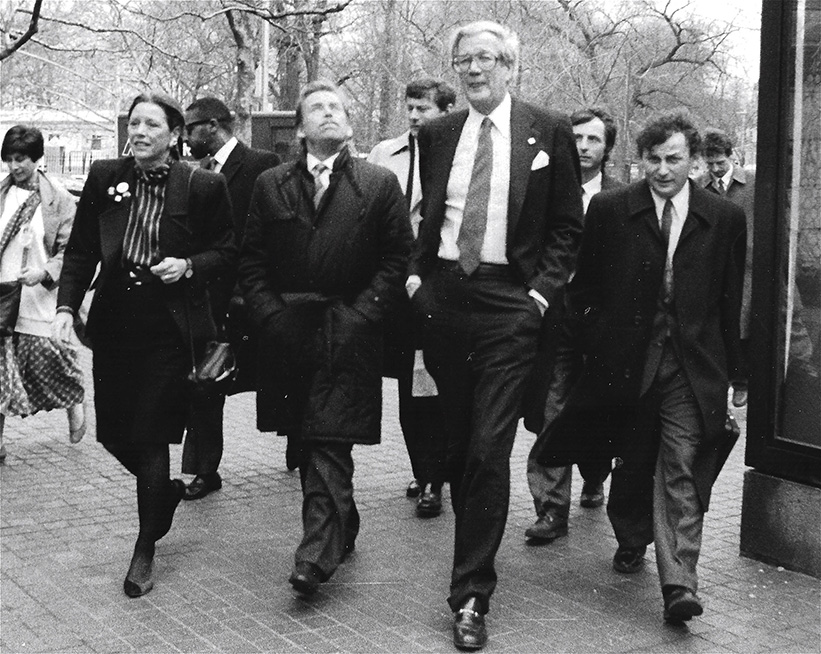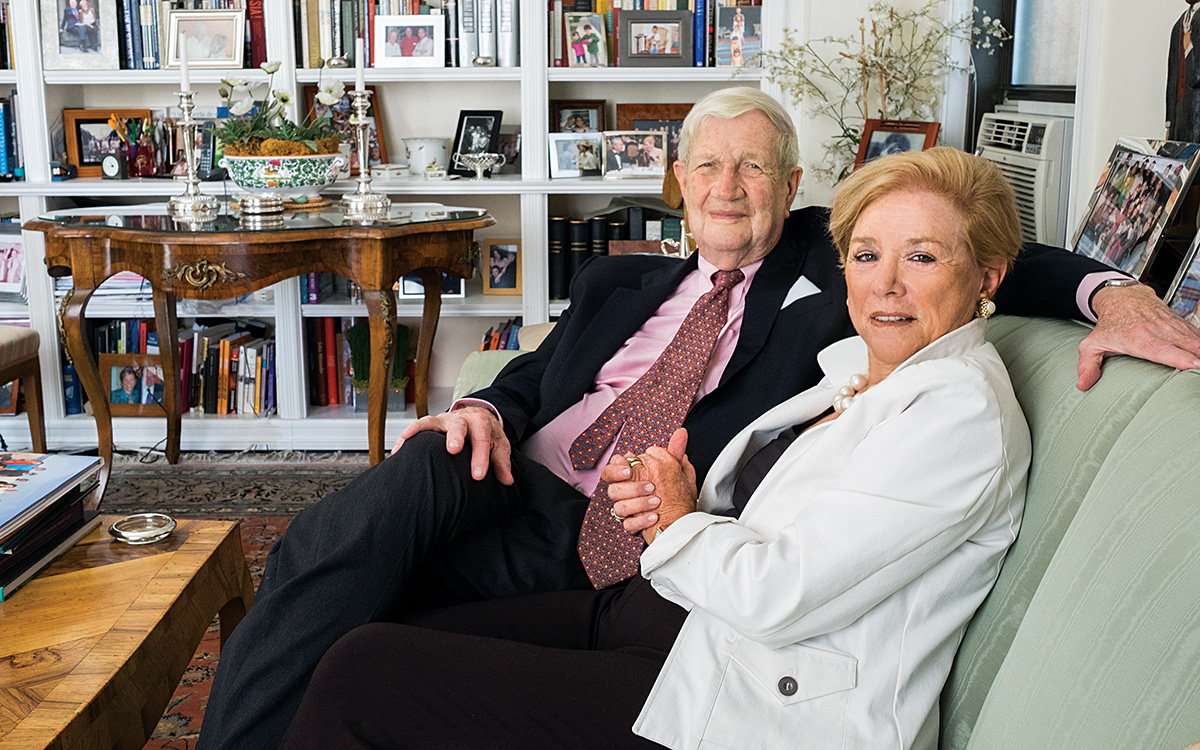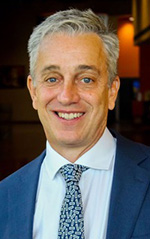A Cold War Ambassador’s Lessons for Today
Ambassador William Luers’ work in Cold War–era Prague demonstrates that pursuing the U.S. national interest and human rights need not conflict.
BY STEPHEN R. GRAND
In 1983 Ambassador William Luers—who died this May just shy of his 96th birthday—thought his next posting would be Madrid, but the Reagan White House decided otherwise. Instead of Spain, they sent him to be U.S. ambassador to Czechoslovakia during one of the darkest moments of the Cold War, as saber-rattling between the Reagan administration and the Soviets threatened nuclear war. At the time, Czechoslovakia was so far off the State Department’s diplomatic radar screen—“at the bottom of the heap of countries of interest to the United States,” in Luers’ words—that he was left largely to his own devices.
The story of Ambassador Luers’ and his wife Wendy’s experiences in Cold War–era Prague bears retelling today. The kind of diplomacy that Luers found himself conducting in Czechoslovakia is the laborious but important task of building relationships with foreign governments and publics in the hopes of moving them closer to U.S. interests and values.
Prague Winter

William Luers, second from the right in the foreground, in 2000. To his right is Vaclav Havel, the often-imprisoned poet-playwright who later became the president of Czechoslovakia.
The New York Times / Redux
In 1983 the Czechoslovak government was among the most brutal Stalinist regimes in Eastern Europe. A Soviet military invasion 15 years prior had crushed the Prague Spring of 1968—a popular reform movement that had sought to create in the country “socialism with a human face” (a less repressive, more market-oriented version of Marxism-Leninism). In the aftermath of the invasion, the Soviets installed a largely Slovak government of communist hard-liners that dismantled the ’68 reforms, purged reformist elements from the ruling communist party, and suppressed any remaining political dissent within society.
By the time the Luerses arrived in December 1983, this process of “normalization” was complete, and the situation in the country seemed as gray and bleak as the Prague sky in the dead of winter. Life had become so circumscribed for ordinary Czechs and Slovaks that some joked it had shrunk simply to three things: “You laugh, you drink beer, you make love.” And State Department policy toward the Czechoslovak regime, as Bill recounted, was simply: “Don’t deal with them.”
When Bill Luers, as is customary, went to present his diplomatic credentials to Czechoslovak President Gustav Husaak, the latter warned that relations between their two countries had never been so bad (a significant statement given that President Woodrow Wilson, following World War I, helped birth an independent Czechoslovakia).
The recent U.S. deployment of Pershing II missiles in Europe, he cautioned, risked a third World War. He further informed Luers that he would not get to meet any senior Czechoslovak officials during his tenure as ambassador, beyond the Foreign Minister, save for at formal occasions where protocol obliged them to invite the entire ambassadorial corps. Luers then presented his credentials to Foreign Minister Bohuslav Chnoupek, who told him much the same but offhandedly asked if he would like to go hunting.
Luers, who had never shot a weapon before, readily accepted the invitation, and purchased two Czechoslovak-made shotguns and later a rifle. The Foreign Minister taught him to hunt pheasant, rabbit, and boar, and brought him along on weekend outings with the Soviet and East European ambassadors and other senior members of the party and government, including the powerful Minister of Interior and the head of the secret police. It helped that, having been posted previously in Moscow, he spoke Russian fluently and could converse easily with the group. As Luers recounted, it “turned out to be a major source of my access to that closed government.”
He also attended all the formal diplomatic events: the state celebrations of Czechoslovak holidays, the trade fairs, and the independence-day celebrations that other countries hosted at their embassies. These were the only other occasions where he could rub shoulders with top officials other than the Foreign Minister, and within the safety of such a formal setting, they proved willing to talk.
Luers’ efforts to build relationships with important members of the communist regime paid dividends. Before his term as ambassador ended in 1986—when he left the Foreign Service to become president of New York’s Metropolitan Museum of Art—he concluded an agreement with the Czechoslovak Foreign Ministry to open wide-ranging talks between the two governments.
Based on the Helsinki Accords that West European governments negotiated with the Soviets and signed along with the United States and Canada in 1975, the agreement called for bilateral discussions on three “baskets” of issues: security, trade and technology, and, importantly, human rights. So unusual was the agreement that the U.S. assistant secretary of State for Europe traveled to Czechoslovakia to sign it—the highest-level U.S. official to visit since World War II.
From these efforts, Luers was also able to acquire a valuable nugget of intelligence regarding how Mikhail Gorbachev ascended to power in the Soviet Union. While watching the Soviet evening news on television in 1985, Luers marveled at the informality and candidness of the new Soviet Communist Party leader, who seemed unlike any Soviet apparatchik that he had seen before. Curious to learn more, he asked Czechoslovak Prime Minister Lubomir Strougal, with whom he had developed a relationship, if he could come to see him. The two had worked out an arrangement: Luers would come by Strougal’s office to talk after hours; Strougal would send his driver to transport Luers so no one would know who was visiting.
Alone with him in his office, Luers asked the prime minister what to make of Gorbachev, and the latter responded with a story. He claimed that in 1983, Gorbachev, who was then the youngest member of the Politburo, had visited his mentor Yuri Andropov on his deathbed. There Andropov told him that Konstantin Chernenko would become the next party leader but that he, Gorbachev, would be next in line after Chernenko, who was also very sick.
Andropov further instructed Gorbachev that he needed to be ready to make major changes when the time came, because the Soviet system could not keep pace economically or technologically with the United States in another arms race, and urged him to use the time to consult extensively with the experts who had designed Nikita Khrushchev’s reforms in the 1960s. Luers cabled this bombshell back to a State Department that still regarded Gorbachev as just another Soviet bureaucrat.

Bill and Wendy Luers at their home in New York City, 2015.
Don Hamerman / Hamilton College
Engaging Through the Arts
While Ambassador Luers was building relationships within Czechoslovak officialdom, he and Wendy were also reaching out to the country’s disaffected artists and intellectuals. Six years earlier, in January 1977, several hundred of them had bravely issued a public manifesto, known as Charter 77, calling on the Czechoslovak government to abide by the human rights provisions contained in the Helsinki Accords that it had signed.
The regime responded harshly, dismissing many of the signatories from their jobs and throwing the apparent ringleaders in prison. By the time the Luerses arrived in 1983, the Chartists were coalescing into the country’s main dissident movement, even though they were still little known at home or abroad. And the most prominent of these dissidents, the playwright Vaclav Havel, had recently emerged from four years in prison (his weekly letters home to his wife provided the basis for his famous book Letters to Olga, which was already circulating clandestinely in the country).
Bill and Wendy hosted myriad cultural events at the embassy, beginning with a vernissage (a private art viewing) of American contemporary paintings, at which they first met Havel. Many of the events were built around the cavalcade of American luminaries—from Frank Stella and Richard Diebenkorn, to Kurt Vonnegut and John Updike, to George Kennan and John Kenneth Galbraith—whom the two invited to visit Czechoslovakia.
In all, the now-public secret police files record a remarkable 287 overnight guests at the ambassador’s residence during their tenure. Having been starved of access to the West since 1968, the Czech artists and intellectuals invited to these events lapped it up. On these occasions, they circulated around the embassy in awkward proximity to the high-level Czechoslovak officials the Luerses also invited—who had been their jailers in some instances.
In this outreach to artists and intellectuals, Wendy proved to be Bill’s secret weapon. Having worked previously for Amnesty International, she was able to establish an immediate rapport with many of the dissidents. She also could move around more freely than Bill. As Wendy explained, “They [the Communists] were such chauvinist pigs that they assigned a third-rate StB [secret police] agent to follow me.” So, she took the lead in traveling around the country and introducing herself to the country’s cultural figures, inviting them into their social circle.
Where they could, the pair also tried to engage directly with the Czechoslovak public. They made an annual pilgrimage to the town of Lany to pay their respects at the grave of Tomas Masaryk, Czechoslovakia’s first president. Each year they also traveled to southern Bohemia to mark the anniversary of American troops liberating that part of the country at the end of World War II. Bill would pre-record his speech and have it air on Radio Free Europe beforehand as a way of building a crowd.
Luers showed how, with a little finesse, it is possible to engage both with authoritarian governments and their citizens in ways that win friends to America’s side.
In each town and city that the Luerses visited, curious locals would come out in the hundreds and even thousands. At a time when “nothing was happening, but everything mattered”—every gesture and every symbol—it was a way of reminding the populace of the positive role that the United States had played in their history. The regime protested these trips, often flooded the town squares with water to make them inaccessible, and, in one instance, possibly tried to poison Bill—but the Luerses persevered.
Even after they departed Czechoslovakia for New York in 1986, Bill and Wendy continued their relationship with Czechoslovakia’s artistic and intellectual community. They made a practice of traveling back to the country each Christmas for visits. Each New Year’s Eve, they hosted a dinner for their friends at the famous Prague restaurant U Sedmi Andelu (At the Seven Angels).
When the Velvet Revolution swept these dissidents to power three years later, in late 1989, Bill and Wendy found themselves at the heart of the action. The night before Havel’s inauguration on Jan. 1, 1990, their annual At the Seven Angels dinner with friends became the de facto pre-inaugural celebration. Vaclav Havel wore to his inaugural a tie borrowed from Bill, and Olga, a blouse from Wendy.
When Havel made his first official visit to the United States that January, his office turned to the Luerses to help organize the New York leg (and future Secretary of State Madeleine Albright, the Washington leg). In the aftermath of that visit, Wendy, who had become the head of the newly formed Charter 77 Foundation–U.S., organized a group of top constitutional experts to assist the new government in revising Czechoslovakia’s Soviet-era constitution.
Lessons in Diplomacy
Today, Bill Luers’ experience as ambassador to Czechoslovakia is rich with lessons. He demonstrated that the pursuit of the U.S. national interest and of human rights need not conflict. It requires a delicate dance, but Luers showed how, with a little finesse, it is possible to engage both with authoritarian governments and their citizens in ways that win friends to America’s side, and thereby advance its interests, while creating political openings for internal forces of change.
Years later, Luers explained that his aim was not to subvert the Czechoslovak state but to elevate the standing of the dissidents. “We were not trying to promote rebellion. … They were [a] human rights group. They were promoting theater, the arts, and access to literature and thinking.” He calculated that by “shining the international light on them, they would have increased protection from being thrown into jail.”
In the case of Czechoslovakia, that additional space proved to be all that the Chartists required—along with Gorbachev’s repudiation of the Brezhnev Doctrine, which had stipulated that the Soviet Union would intervene militarily whenever its satellite states deviated politically from Moscow’s line—to help eventually usher in democratic change to the country. In the intervening years, despite many setbacks and shortcomings in their democratic development, the Czech Republic and Slovakia (Czechoslovakia peaceably split in two in 1993) have proved far better partners to the United States than their communist predecessors.
For the foreseeable future, this should be the kind of work in which U.S. diplomats are engaged. They will be most effective if they remain true to their own values while doing so—as Bill and Wendy Luers so ably did.
When sharing or linking to FSJ articles online, which we welcome and encourage, please be sure to cite the magazine (The Foreign Service Journal) and the month and year of publication. Please check the permissions page for further details.
Read More...
- “Beyond the Cold War: A New Multilateral Agenda” by William Luers, The Foreign Service Journal, December 2008
- “Former US ambassador to Prague, William Luers, on what it was like to serve in Communist Czechoslovakia,” Radio Prague International, April 2018
- “A Gift of Peace” by James D. Bindenagel, The Foreign Service Journal, November 2019



